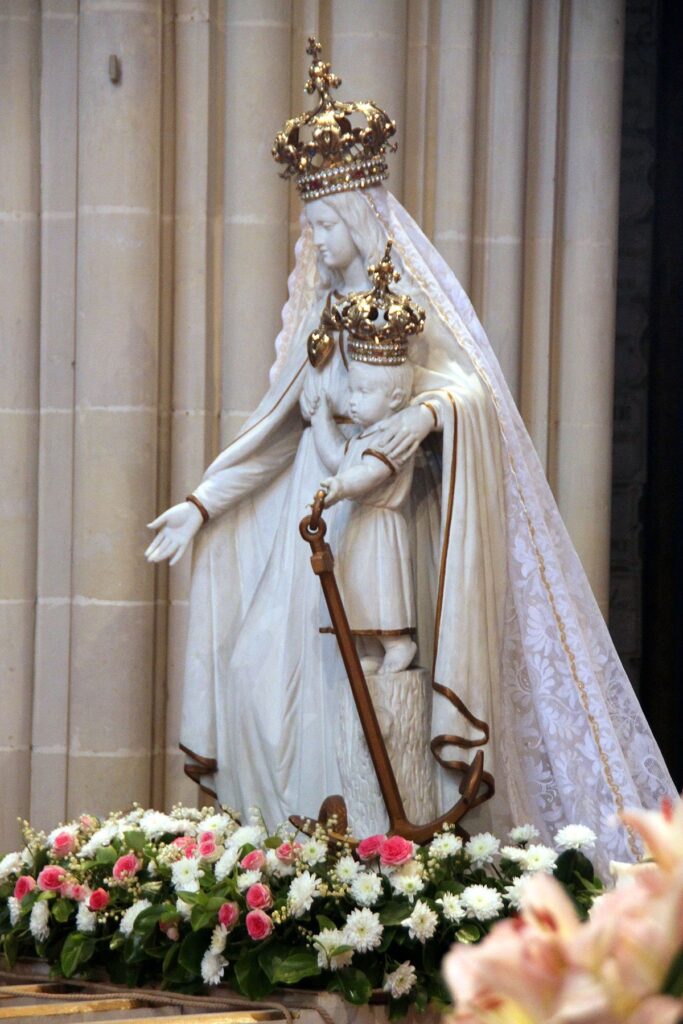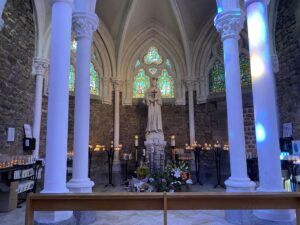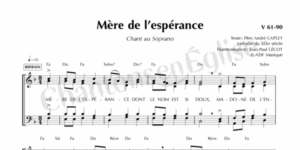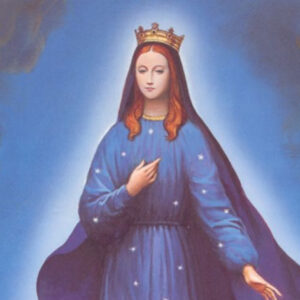Memorial day
17 January
Saint-Brieuc
Our Lady of Hope at Saint-Brieuc, Brittany sits on a hill overlooking the town. it had been the site of a shrine to Saint Peter since about 1500. In 1717, the site came into the care of a confraternity of merchants dedicated to the Immaculate Conception. They built a new chapel and in 1719 dedicated it to Mary Immaculate and it soon became a place of pilgrimage. In 1724, Benedict XIV endowed the sanctuary with indulgences.
During the French Revolution, the statue of Our Lady was decapitated by revolutionaries. In 1796 the chapel was bought by the then major of Saint-Brieuc, M. Prud’homme. Some years later, his grandson, Father Paul-Marie Prud’homme (1812-1882), was to take charge of the chapel. Father Paul-Marie Prud’homme had been ordained in 1836 and made Canon in 1845
Following the second French Revolution in 1848, the Confraternity changed its name to the Archconfraternity of Our Lady of Hope. and Canon Paul-Marie Prud’homme became Chanoine-Doyen du Chapitre de la Cathédrale de Saint-Brieuc, Fondateur et Directeur de l’Archiconfrérie de Notre-Dame d’Espérance (Canon-Dean of the Chapter of the Cathedral of Saint-Brieuc, Founder and Director of the Archconfraternity of Our Lady of Hope). The order from the bishop interestingly includes a reference to the church’s chapel of Ss Peter & Paul
Art. 1st. We establish and canonically authorise, in the chapel of the Immaculate Conception, known as the SS. apostles Pierre-et-Paul, of Saint-Brieuc, a pious Association under the title of Our Lady of Hope, to obtain the salvation of France, through the intercession of the Most Blessed Virgin Mary;
The Archconfraternity committed itself to the promotion of the shrine of Our Lady of Hope and for prayers for the salvation of France. The membership of the Archconfraternity of Our Lady of Hope increased rapidly, and within months there were more than a hundred thousand members. To support this work Canon Prud’homme composed the canticle Mother of Hope which quickly became famous and was sung throughout France. The words are distinctly nationalistic and jingoistic but have to be considered to be of their time.
In 1854, the simple chapel was replaced with a splendid neo-gothic church which in 1902 was to become a basilica. Meanwhile, the activities of the Archconfraternity of Our Lady of Hope expanded beyond the diocese of Saint- Brieuc, and in 1862, thanks to the support of Pius IX were given universal scope. The chapel/sanctuary in Saint-Brieuc had been considered by the supporters of Canon Prud’homme to be dedicated as a special place of prayer for France, however, this is not the focus today

photo with permission from the Parish of St Brieuc https://paroisses.saint-brieuc-ploufragan.catholique.fr/
Pontmain
Pontmain lies about 90 miles East of Saint-Brieuc
In 1861, Kaiser Wilhelm I had ascended the throne of Prussia and Otto von Bismark was appointed chancellor. Their goal was to unite all German-speaking states into a single country. Prussia waged three quick wars: First, against Denmark, in 1864, taking Holstein; second, against, Austria in 1866, putting Prussia in control of Germany; and finally, against France in 1870.
By mid-January, 1871, the Prussian army was just a few miles from the town of Pontmain, which was located right inside the French defensive line. The citizens feared for their lives. Father Guerin, who had been the parish priest for thirty-five years, instructed the children to pray to the Blessed Mother for protection.
On the evening of Tuesday, January 17, at about five o’clock, twelve-year-old Eugene Barbadette was leaving his father’s barn. He looked up into the starry sky and saw a beautiful Lady standing in the air, about twenty feet above the roofline and between the two chimneys of Jean and Augustine Guidecoq’s home across the way. The Lady was wearing a dark blue dress covered with gold stars, a black veil, and a simple gold crown. Eugene stood there entranced in the snow for about fifteen minutes.
His father and ten-year-old brother, Joseph, came out of the barn. Eugene cried out, “Look over there! Above the house! What do you see?” Joseph described the Lady in the same way Eugene had seen her. Their father did not see her, so he sternly ordered them to return to feeding the horses in the barn.
For whatever reason, a little later, the father told the brothers to go out and look again. They again saw her. Joseph kept saying, “How beautiful she is! How beautiful she is!” Their mother, Victoria Barbadette, had now appeared on the scene and told Joseph to be quiet since he was attracting so much attention. Knowing that the boys were honest and did not lie, she said, “It is perhaps the Blessed Virgin who appears to you. Since you see her, let us say five Our Fathers and five Hail Marys in her honour.” (The brothers were truly pious: They had begun their day serving Holy Mass, reciting the Rosary and offering the Stations of the Cross for the intentions of their older brother, serving in the French army.)
After reciting the prayers in the barn so as not to attract attention, Mrs Barbadette asked if the children still saw the Lady. When they replied, “Yes,” she went for her eyeglasses. When she returned, bringing their sister Louise with her, neither of them saw anything. The mother’s mood changed, and she accused them of lying.
Mrs Barbadette then thought of calling the religious sisters. She said, “Sisters are better than you are. If you see, they will certainly see, too.” Sister Vitaline also knew that the boys were honest. However, she too could not see the Lady. Sister Vitaline then went to a neighbouring house and asked two little girls, Francoise Richer (age eleven) and Jeanne-Marie Lebosse (age nine) to come with her. The two girls described the Lady in the same way.
Sister Marie Edouard had now joined the group. Upon hearing what the two girls had said, she went to bring Father Guerin and another child, Eugene Friteau (six-and-one-half years old). Eugene also saw the Lady. By this time a large crowd of about fifty villagers had gathered. Augustine Boitin, only twenty-five months old, reached to the Lady and said, “The Jesus! The Jesus!” Only these six children would see the vision of Our Lady of Hope.
Father Guerin told everyone to pray, so they knelt and said the Rosary. Sr. Marie Edouard led the crowd in reciting the Magnificat. Gradually, a message in gold letters appeared in the sky: “But pray my children.” All of the children saw the same message.
Sister Marie Edouard then led the crowd in singing the litanies of the Blessed Virgin. The message continued to unfold, “God will hear you in a short time.”
News came that the Prussians were now at Laval, very close to Pontmain. The message continued, “My Son allows Himself to be moved with compassion.” When the children had announced this message, Father Guerin told the crowd to sing a hymn of praise. Sr. Marie Edouard said, “Mother of Hope, of name so sweet, protect our country, pray for us, pray for us!” The people responded, “If [the Prussians] were at the entrance of the village, we should have no fear now!”
At the conclusion of the hymn, the message disappeared. The crowd then sang a hymn of repentance and reparation to Jesus. Our Lady appeared. She wore a dark blue dress covered in stars, appeared sad, carried a large red crucifix, and below her were the words Pray please. God will hear you soon. My Son allows Himself to be moved with compassion.
At 8:30 p.m., the people sang, Ave, Maris Stella, and the crucifix disappeared. She again smiled, and two small white crosses appeared on her shoulders. She lowered her hands, as seen in images of the Immaculate Conception. A white veil gradually covered her, from foot to crown. At about 8:45 p.m., the children said, “It is over.” Our Lady had disappeared.
While this apparition was happening, General Von Schmidt received orders from the Prussian High Command to halt his campaign and withdraw. Ten days later, an armistice was signed between France and Prussia. The miraculous intercession of our Blessed Mother had saved Pontmain.
(Quoted from What is the story behind our Blessed Mother’s title, “Our Lady of Hope”?, Catholic Straight Answers)
The apparitions were given Church approval and recognition by the local bishop in February 1872 for devotion to Our Lady of Hope of Pontmain. The final approval by the Holy See for the apparitions of Our Lady of Hope was given in 1932 during the pontificate of Pope Pius XI by Eugenio Cardinal Pacelli who later became Pope Pius XII
The children who witnessed the apparition were
- Eugene Barbedette (12 years old)
- Joseph Barbedette (10 years old)
- Françoise Richer (9 years old)
- Jean-Marie Lebossé (12 years old)
- Auguste Auclaire (10 years old)
Eugene Barbedette entered the seminary but died young at the age of 29. Joseph Barbedette also pursued a religious vocation and became a Marist Brother, taking the name Brother Joseph. He worked in various locations and eventually died in 1912.
Françoise Richer married and had children. She passed away in 1934.
Jean-Marie Lebossé became a teacher and eventually a principal. He was known to share the story of the apparition throughout his life. He died in 1932.
Auguste Auclaire became a priest, and his life was dedicated to serving the church. He passed away in 1927.
References
- Our Lady of Pontmain: https://catholicsaints.info/our-lady-of-pontmain/
- Our Lady of Hope, University of Daytone: https://udayton.edu/imri/mary/o/our-lady-of-hope.php
- What is the story behind our Blessed Mother’s title, “Our Lady of Hope”? https://catholicstraightanswers.com/what-is-the-story-behind-our-blessed-mothers-title-our-lady-of-hope/
- 2013-9. Du cantique « Mère de l’Espérance » qui fut chanté au cours de l’apparition de la Très Sainte Vierge à Pontmain. https://www.riposte-catholique.fr/archives/91768
- Prière de l’Abbé Paul-Marie Prud’homme http://site-catholique.fr/index.php?post/Priere-de-Abbe-Paul-Marie-Prudhomme
- l’Abbé Prud’homme http://www.infobretagne.com/saintbrieuc-prudhomme.htm
- Notre Dame de Espérance http://www.virgoasis.com/ND_d_Esperance.html
- Notre-Dame D’Espérance http://www.infobretagne.com/saintbrieuc-notre-dame-esperance_1.htm



